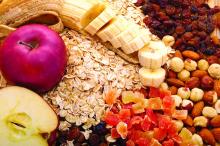Overweight individuals whose stool samples were abundant in Prevotella species lost about 2.3 kg more body fat on a 6-month high-fiber diet than individuals with a low ratio of Prevotella to Bacteroides, according to a randomized trial of 62 Danish adults.
The findings help explain why a high-fiber diet does not always produce meaningful weight loss, said Mads F. Hjorth, PhD, of the University of Copenhagen, and his associates. An “abundance of Prevotella” in the gut microbiome might underlie the “recent breakthrough in personalized nutrition,” they wrote in the International Journal of Obesity.
In this study, overweight adults consumed either a high-fiber diet rich in whole grains, fruit, and vegetables, or a control diet designed to match the macronutrients of the average Danish diet. The high-fiber diet also was higher in protein (18% vs. 16.4%) and lower in fat (30.4% vs. 33.8%) than the control diet. The researchers performed genera-specific quantitative polymerase chain reaction of stool samples at baseline and tracked weight, waist circumference, and fat mass using dual-energy X-ray absorptiometry (Int J Obes [Lond]. 2017 Sep 8. doi: 10.1038/ijo.2017.220).At the start of the study, 28 (45%) participants had a high (0.28; 95% confidence interval, 0.11-7.5) ratio of Prevotella to Bacteroides and 34 (55%) had a much lower ratio (0.00007) but did not otherwise differ significantly by age, sex, body weight, or fasting insulin levels. After 26 weeks, the high-Prevotella group lost an average of 3.2 kg more fat on the high-fiber diet than the control diet (P less than .001). In contrast, the low-Prevotella group lost only 0.9 kg more fat with the high-fiber diet, a statistically insignificant difference from the control diet. Changes in waistline circumference reflected the findings – the high-fiber diet produced a 4.8-cm average reduction in the high-Prevotella group, compared with a 0.8-cm reduction in the low-Prevotella group.
Next, the researchers asked all 62 participants to follow the high-fiber diet, but did not provide them with food. After 1 year, the high-Prevotella group had maintained a 1.2-kg weight loss, compared with baseline, while the low-Prevotella group had regained 2.8 kg of body weight (P less than .001). Thus, baseline Prevotella-to-Bacteroides ratio explained a 4-kg difference in responsiveness to the high-fiber diet, the researchers concluded. The difference was even more marked when they excluded eight participants with undetectable levels of Prevotella.
Only two individuals switched from a low to a high Prevotella-to-Bacteroides ratio during the 6-month intervention period, which reflects prior findings that the intestinal microbiome is difficult to shift without “extreme changes, such as complete removal of carbohydrates from the diet,” the researchers wrote. Individual gut microbiome might affect energy absorption from different types of foods, the ability to utilize fiber, gut-brain signaling, or the secretion of hormones affecting appetite, they hypothesized. Thus, Prevotella-to-Bacteroides ratio “may serve as a biomarker to predict future weight loss success on specific diets.”
Gelesis provided funding. Dr. Hjorth and two coinvestigators reported having applied for a patent on the use of biomarkers to predict response to weight loss efforts. The remaining five researchers had no conflicts.


